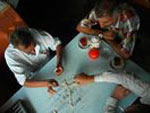Embroidery in Azerbaijan
 Embroidery is the most ancient folk art revealing rich spiritual world of Azerbaijani people. The technique and a composition of Azerbaijani embroidery traces its roots back to extreme antiquity.
Embroidery is the most ancient folk art revealing rich spiritual world of Azerbaijani people. The technique and a composition of Azerbaijani embroidery traces its roots back to extreme antiquity.
The beginning of Azerbaijani embroidery can be established on the basis of archeological data. The simplest ornaments similar to the embroidered ones - straight lines and broken lines, zigzags, dot ornament, circles, triangles, diamonds - can be found on ceramic vessels of the early Bronze Age (3,000 BC).
The embroidered articles were distinguished by abundance and variety of ornaments most popular of which were flowers: a rose, narcissus, pink, poppy, lily, blossoms of fruit trees as well as ears and leaves of various shapes.
The geometrical embroidery patterns consisted of straight lines and broken lines, zigzags, triangles, quadrangles, six - and octahedral rosettes, diamonds, stars and the symbolical image of the sun.
The favored embroidery patterns showed birds: a nightingale, peacock, pigeon, parrot, hoopoe, sparrow, pheasant, quail, partridge and others. From among the fauna representatives the most popular were goitered gazelles, turtles, snakes-dragons, horses, etc.
The popular household utensils were also a topic for embroidery: pink water vessels, comb cases, cosmetics bottles, jugs and others. The most widespread Azerbaijani embroidery types were: gold sewing, damask stitch, chain stitch; spangles, beads, platelet sewing, "pinning", motif, spiral embroidery and fillet work.
The most ancient of all kinds of embroidery is gold sewing. It was done on closely woven fabrics. The best material for this was one-color velvet in red, claret, violet and green. Embroidered was also done on thin cloth of various tones, brocade, satin and morocco leather. For gold sewing they used factory-made gold or silver threads.
The most often embroidered items were outer women's wear, head wears, household articles, horse harness ornaments and smaller items. There was even a custom to include things decorated with gold sewing into the bride's dowry.
The basic fabrics for chain stitch were locally made or imported velvet and cloth of red, black and deep blue colors. A complex and intricate pattern was executed by means of bright silk threads on a dark background. Chain stitch was not exclusively women's craft. Many men showed their great skill in this kind of applied art. First a craftsman embroidered a contour line of the future drawing on a tambour fastened material and then filled the entire internal field with embroidery.
Chain stitch was used to decorate women's wear, cushion cases, bath mats, and coverlets.
Another widely used technique of embroidery was damask stitch. This embroidery type was created by means of silk and woolen threads of soft pastel tones often in combination with gold ones. Damask stitch was applied clothes, wall ornaments, face veils, curtains etc.
Very interesting are pearls and beads embroidery patterns which decorated apparel elements, household objects etc.
Spangle embroidery is the technique of sewing spangles onto a fabric along the contour of the color silk thread patterns.
Motif and spiral are relatively young embroidery techniques.

